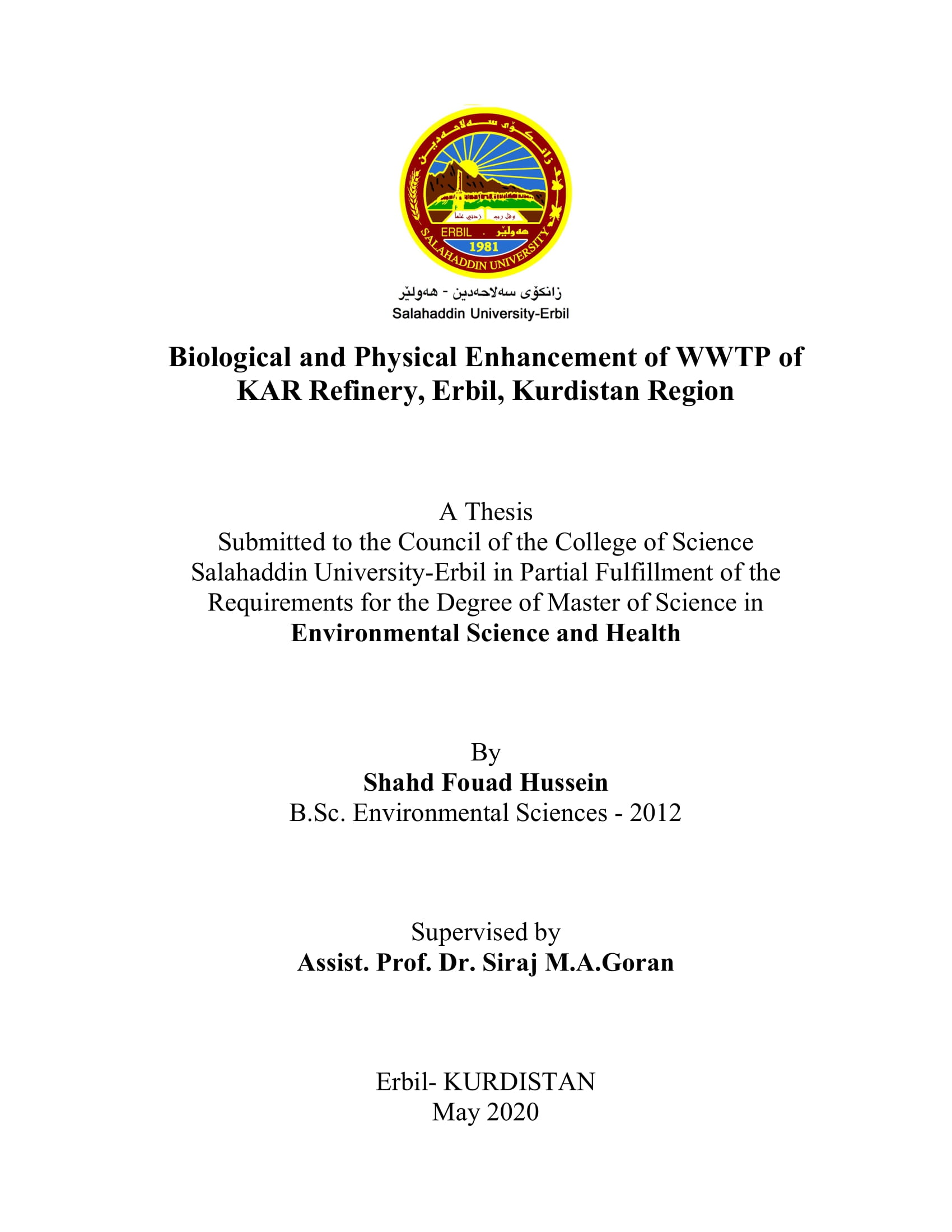
SUMMERY
Kurdistan Region-Iraq is one of the oil-producing regions with many refineries distributed in the region, consequently accumulation of large quantities of waste products, contamination of water by crude oil or oil products, which is well known to be harmful to human life and local biota.
The samples of oily wastewater collected from KAR oil refinery as one of the main oil refineries in Kurdistan region of Iraq, which is located at the north west of Erbil governorate. At Kawrkosek district, 40 km west of the city of Erbil, and occupies 2.5 km2 of land on the left of upper ZAB River. At this stage, the refinery consists of three production lines for crude oil refining and the production, storage, distribution and supply of petroleum products in accordance with applicable standards, representing the first crude oil refining plant in Kurdistan since 2005. It has established as par a contract between the Ministry of Oil and the Ministry of Industry with a refining capacity of 40,000 barrels per day. It supports Kurdistan economically and has direct and indirect effect on the environment. Two sites in the wastewater treatment of the refinery were selected the inlet point which is the point when the wastewater collected from the refinery and then enter in to the wastewater treatment plant. The second point is the outlet of WWTP, which is the final effluent of treated water, which discharge in to Greater Zab River.
In order to evaluate the status of input and output effluents (physically and chemically treated by KAR, WWTP) and after that treated it with bacteria and UV light. Some physicochemical characteristics and total petroleum hydrocarbons (TPH) contents were considered in current research to evaluate the pollution status and the role of bacillus bacteria to and UV light to degradation hydrocarbon contents in oily wastewater.
The collected effluents samples were transferred by box contain ice pack to the laboratory of college of science- Salahaddin University-Erbil, and two methods were tested for reduction of petroleum:
First: The biological degradation by using inoculum of bacillus subtilis sp. with aeration. Where samples collected every seven days and followed up the experiment continuously. Degradation process continued for (28) days.
Second: Radiation treatment done by exposure wastewater to ultra violates (UV) radiation with aeration, and the processing of degradation was continued for (2) weeks.
Two experiments were carried out during 2019. The first experiment conducted during March and August. The second experiment performed in June 2019. Where the aliphatic and aromatic compounds degraded and converted from long chains to short-chain compounds.
Physical and chemical properties of studied water were analyzed for; temperature, electrical conductivity, pH, biological oxygen demand, chemical oxygen demand, chloride, total dissolved solids, total suspended solid, total hardness, reactive phosphorus, and ammonia with values ranged from (21.3-27.8 oC), (618-932 μS/cm), (6.6-8.3), (50-925 mg/l), (94-2061 mg/l), (108-636 mg/l), (625-932 mg/l), (0.8-3.8 mg/l), (239.4-393.3 mg CaCO3/l), (0.45-54.95 µgPO4-P/l), (4.128-18.938 mg/l) respectively. While the results of analysis of wastewater samples that treated by UV light as follow: (28.7-33.2 oC), (1720-6510 μS/cm), (0.89 -7.60), (75-600 mg/l), (134-995 mg/l), (68-248 mg/l), (850-3240 mg/l), (2-5.14 mg/l), (171-769.5 mgCaCO3/l), (1.65-3.2 µgPO4-P/l) and (0-5.584 mg/l) respectively.
Biodegradation results of oily wastewater samples after five weeks of treatment by bacteria bacillus subtilis was only C19 remained in the water, which is nonadecane with a concentration (270 µg/l) due to its hard structure for breakdown by bacteria. While the result of treated samples of oily wastewater (inlet sample) after two weeks of exposure to UV light, were C13 and C17, which is tridecane and heptadecane. The concentrations of these carbons were (10070 and 2630 µg/l). While, the result of the treated sample of discharged (outlet) oily wastewater were C8 and C17, which are octane and heptadecane. The residual concentrations were (1570 and 20 µg/l).
The biodegradation of hydrocarbon by bacillus bacteria was obvious, most of hydrocarbons degraded and other disappeared. While for radiation treatment process it gave best results were the ratio of degradation of crude oil or hydrocarbon compounds by UV was obvious in two weeks. Also, it’s cheaper and less complexity if it compared with bacteria, which take long time to consume hydrocarbon.
